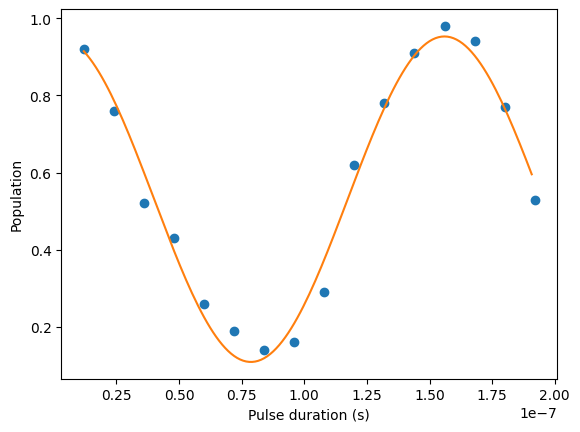Working with Hello Pulse
In this section, you will learn how to characterize and construct a single qubit gate directly using pulse on a Rigetti device. Applying an electromagnetic field to a qubit leads to Rabi oscillation, switching qubits between its 0 state and 1 state. With calibrated length and phase of the pulse, the Rabi oscillation can calculate a single qubit gates. Here, we will determine the optimal pulse length to measure a pi/2 pulse, an elementary block used to build more complex pulse sequences.
First, to build a pulse sequence, import the PulseSequence class.
from braket.aws import AwsDevice from braket.circuits import FreeParameter from braket.devices import Devices from braket.pulse import PulseSequence, GaussianWaveform import numpy as np
Next, instantiate a new Braket device using the Amazon Resource Name (ARN) of the QPU. The following code block uses Rigetti Ankaa-3.
device = AwsDevice(Devices.Rigetti.Ankaa3)
The following pulse sequence includes two components: Playing a waveform and measuring a qubit. Pulse sequence can usually be applied to frames. With some exceptions such as barrier and delay, which can be applied to qubits. Before constructing the pulse sequence you must retrieve the available frames. The drive frame is used for applying the pulse for Rabi oscillation, and the readout frame is for measuring the qubit state. This example, uses the frames of qubit 25. For more information about frames, see Roles of frames and ports.
drive_frame = device.frames["Transmon_25_charge_tx"] readout_frame = device.frames["Transmon_25_readout_rx"]
Now, create the waveform that will play in the drive frame. The goal is to characterize the
behavior of the qubits for different pulse lengths. You will play a waveform with different lengths
each time. Instead of instantiating a new waveform each time, use the Braket-supported FreeParameter
in pulse sequence. You are able to create the waveform and the pulse sequence once with a free parameters,
and then run the same pulse sequence with different input values.
waveform = GaussianWaveform(FreeParameter("length"), FreeParameter("length") * 0.25, 0.2, False)
Finally, put them together as a pulse sequence. In the pulse sequence, play plays the specified
waveform on the drive frame, and the capture_v0 measures the state from the readout frame.
pulse_sequence = ( PulseSequence() .play(drive_frame, waveform) .capture_v0(readout_frame) )
Scan across a range of pulse length and submit them to the QPU.
start_length = 12e-9 end_length = 2e-7 lengths = np.arange(start_length, end_length, 12e-9) N_shots = 100 tasks = [ device.run(pulse_sequence(length=length), shots=N_shots) for length in lengths ] probability_of_zero = [ task.result().measurement_counts['0']/N_shots for task in tasks ]
The statistics of the qubit measurement exhibits the oscillatory dynamics of the qubit that oscillates between the 0 state and the 1 state. From the measurement data, you can extract the Rabi frequency and fine tune the length of the pulse to implement a particular 1-qubit gate. For example, from the data in figure below, the periodicity is about 154 ns. So a pi/2 rotation gate would correspond to the pulse sequence with length=38.5ns.

Hello Pulse using OpenPulse
OpenPulse
Braket uses OpenPulse as the underlying intermediate representation
for expressing pulses in native instructions. OpenPulse supports the
addition of instruction calibrations in the form of defcal (short for “define
calibration”) declarations. With these declarations, you can specify an implementation of a
gate instruction within a lower-level control grammar.
You can view the OpenPulse program of a Braket PulseSequence using the following command.
print(pulse_sequence.to_ir())
You can also construct an OpenPulse program directly.
from braket.ir.openqasm import Program openpulse_script = """ OPENQASM 3.0; cal { bit[1] psb; waveform my_waveform = gaussian(12.0ns, 3.0ns, 0.2, false); play(Transmon_25_charge_tx, my_waveform); psb[0] = capture_v0(Transmon_25_readout_rx); } """
Create a Program object with your script. Then, submit the program to a QPU.
from braket.aws import AwsDevice from braket.devices import Devices from braket.ir.openqasm import Program program = Program(source=openpulse_script) device = AwsDevice(Devices.Rigetti.Ankaa3) task = device.run(program, shots=100)